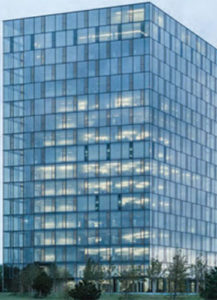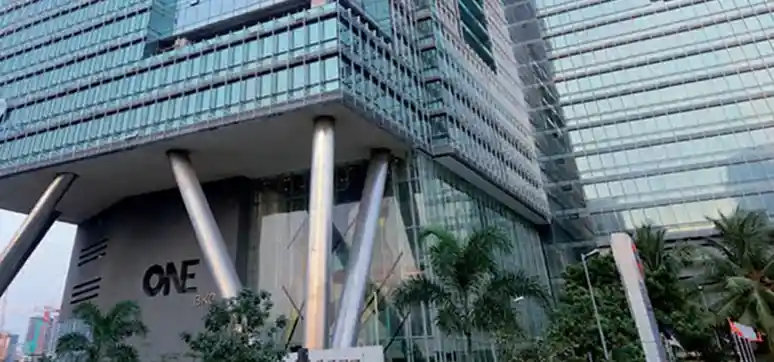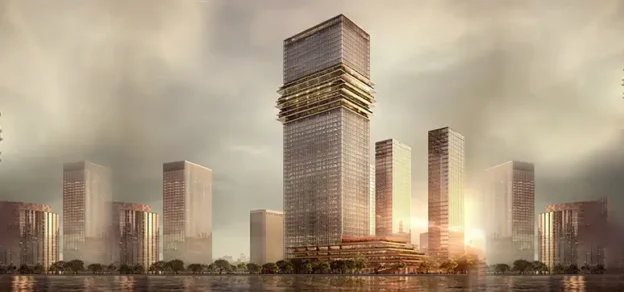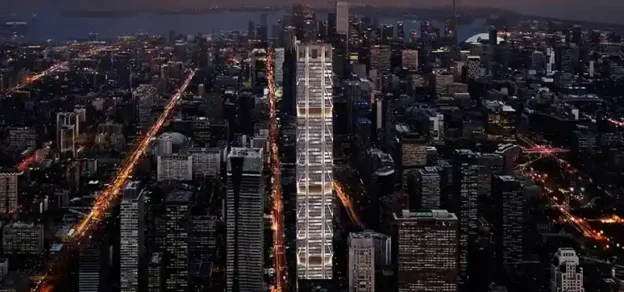During the times of modern architecture and the international style the dream of fully glazed highrise buildings became a sparkling reality – creating astonishing façades, allowing an interaction between inside and outside and paying homage to great views. But in present days due to building regulations and higher sustainability demands this architectural intent has become more and more impossible to realize. Therefore the recently opened Festo Automation Center with its all-glass façade points out the enormous technological accomplishments and the intelligence that lies within the design of the building.

A normal or rather passive building envelope is transformed into an active building component reacting dynamically to changing environmental conditions. As a result cooling energy needed can be reduced by up to 20 per cent and the user comfort can be increased. This high-performance façade is based on a unitized system of two different elements adding up to 8.500 sq m in total. By this the façade is a main part of the new eye-catching 67 m high landmark within the Festo campus, visible from everywhere in the metropolitan region of Stuttgart.
The two façade elements consist of one parallelopening window and a fixed glazing element. The smaller element measuring 0.70 x 4.00 m sets a new standard in manually openable windows and glazing technology. Its parallel opening window can be operated by the user, increasing its comfort also from a psychological point of view. The floor to ceiling glazing consists of a two-piece panel of electro-chromatic glazing. This new glass technology allows changing dynamically the g-value by various steps and therefore lowering the solar radiation and heat income into the building.
This technology also prevents from glare and at the same time ensures a high visibility trough the glazing. Festo also sets a new milestone in this field realizing the largest façade area of electrochromatic glazing in Europe. The bigger façade element is 2.70 x 4.00 m big and is carried out as one fixed glazing panel. With a high quality sun control glass still a good view from the inside is ensured. To counteract glare, an internal blind is needed nevertheless. At the Festo Automation Center, this mandatory blind is used to create a new type of air-exhaust façade.

Thanks to new technical details and an optimization process within the designing face, the textile blind creates an exhaust air corridor between the blind and the glazing. Through this space, the exhaust air from the office space is sucked off taking with it the heat from solar radiation captured by the blind within this corridor. Thanks to this combination of façade engineering and building services, this façade element also features a dynamic g-value lowering the cooling demand inside and creating a higher user comfort thanks to similar surface temperatures throughout the office.
The above mentioned façade systems ensure that already in the first summer since putting the Automation Center into operation in July 2015 the inside temperature never exceeded 26°C even at outside temperatures of up to 40°C. Besides the high energy efficiency, the increase in user comfort, ensuring high job performances, the developed single-skin unitized façade was realized with a depth of only 75mm of glass construction, increasing the usable floor space in the building.
To keep this newly generated absolute view clear at all times a new cleaning robot was used for the Automation Center. Thanks to vacuum technology this robot can move along the whole façade like a gecko by itself cleaning it in only one day. Finally the façade was designed to incorporate the building into the Festo campus and the companies technological innovation, pneumatic air systems, intelligent control systems and last but not least the companies colours blue and grey – using these colours for the façade profiles. This commitment to the company is highlighted throughout the whole day: a LED-system was integrated into the façade profiles letting the façade sparkle in Festo blue by night as well.
After all the new Festo Automation Center façade is mainly built like a conventional singlelayer unitized façade but thanks to a lot of highly designed and developed details and a smart controlling of the building services, a highly innovative, efficient and sustainable façade could be realized. All these design and technological masterstrokes were only feasible thanks to the openness of the architect, client, industry and research institutes towards new approaches by the façade designer and its leading position in the designing and construction of the façade. This close collaboration made it possible to fulfil all the project targets, queuing in previous ground-breaking construction projects by Festo and realizing innovations as a reference for buildings to come.

The Priedemann Middle East and India is headed by Managing Directors: Anees A. Backer leading the Project Operations across GCC / India, and Micha Pawelka leading the Business Development in the region. With Project Manager – Praveen Chaubey as the point of contact for Priedemann Mumbai office.
Priedemann Offie: 423 Avior Nirmal Galaxy, LBS road, Mulund West 80, Mumbai, India; Phone: +91 222 591 306
The Capital, Mumbai

THE CAPITAL, MUMBAI – FACT FILE
Client: Vijay Associates (WADHWA) Developers
Owner – Developer: Vijay Associates (WADHWA) Developers
Architect: James Law Cybertecture
Project data: approx. 103 m building height
Building function: Commercial Building
Technical features: Stick system façade, Unitised system,
Frameless glazing
Our scope: Typical detailing, Design development, Design
review, Site installation review
Status: Completed 04 / 2013
One BKC, Mumbai
 Fig. 5: One BKC Mumbai, completed in 2015
Fig. 5: One BKC Mumbai, completed in 2015
The Priedemann company was founded in 1993 by Wolfgang Priedemann in Berlin, Germany. With his partners; Lars Anders and Wolfgang Feurlein they expanded the German company into an international brand. Since 1993, the company has provided façade consultancy and design services to investors and developers, architects and general planners, main contractors and fabricators. Priedemann has grown international since, opening branches in the following locations: Dubai, Mumbai, Istanbul, St. Petersburg, Beijing, Nairobi and London. In 2012, Priedemann established their consultancy branch in Mumbai and developed an engineering hub in South India (Cochin) where they train local staff to support all their design activities. ONE BKC, MUMBAI– Fig. 5: One BKC Mumbai, completed in 2015.














